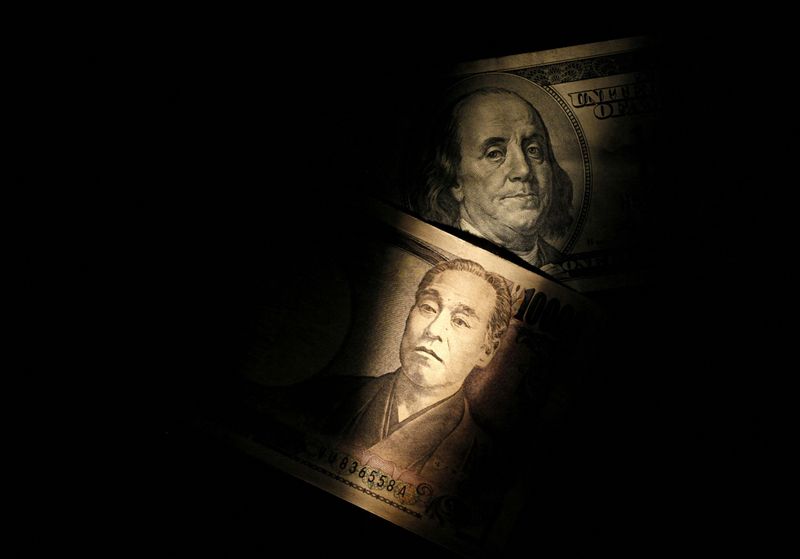By Gertrude Chavez-Dreyfuss
NEW YORK (Reuters) -The dollar posted its best daily gain in two weeks on Tuesday following a jump in benchmark U.S. Treasury yields, while the yen steadied after initially sliding as the Bank of Japan said it would stick to its ultra-loose monetary policy.
The U.S. currency also rose to a one-week high against a basket of currencies.
Investors are focused on next week's meeting of the U.S. Federal Reserve, which will likely signal that it will raise interest rates in March for the first time in more than three years. The fed funds futures have fully priced in the March tightening and four rate hikes in 2022.
"The Federal Reserve will have to become more hawkish with their rate statement in January's meeting following the progress made in the labour market in December and the rise in inflation to a near 40-year high," Simon Harvey, senior FX market analyst at Monex Europe, said in a research note.
"We expect this to provide a floor under the dollar, which has been under pressure over past weeks as the market starts to settle on a more balanced outlook for Fed normalisation."
As investors prepared for the possibility of the Fed being more hawkish than expected, Treasury yields jumped, with two-year yields -- which track short-term rate expectations -- crossing 1% for the first time since February 2020. [US/]
The U.S. 10-year yield also hit a two-year peak of 1.856% overnight.
In line with Treasury yields, the dollar firmed against a basket of currencies, hitting a one-week peak of 95.832, and was last up 0.6% at 95.772.
Chester Ntonifor, chief foreign exchange strategist at BCA Research in Montreal, said the dollar's gains are not sustainable over the longer term, beyond three to six months.
"If the Fed is getting more hawkish than other central banks because of inflation, then there is a dissonance there because inflation is a global problem," he said.
"What the market is telling you is that the Fed will catch up to those central banks that have already hiked rates, but since inflation is a global problem, the Fed cannot hike much faster than other central banks. Therefore, the dollar's rate advantage will narrow against other currencies."
The euro hit a one-week low of $1.1319 and was last down 0.7% at $1.1325.
The currency was largely unmoved by data showing German investor sentiment hit its highest in six months in January on expectations COVID-19 cases will fall by early summer, allowing growth in Europe's largest economy to pick up.
YEN SLIPPED
The yen slid against the dollar after the Bank of Japan said it would maintain its ultra-loose monetary policy even as its global counterparts move towards exiting crisis-mode policies.
By afternoon trading, the dollar was flat against the yen at 114.61 yen
The Australian dollar, meanwhile, fell 0.4% to US$0.7181, while the New Zealand dollar dropped 1.1% to US$0.6768.
========================================================
Currency bid prices at 3:44PM (2044 GMT)
Description RIC Last U.S. Close Pct Change YTD Pct High Bid Low Bid
Previous Change
Session
Dollar index 95.7750 95.2260 +0.59% 0.117% +95.8320 +95.1260
Euro/Dollar $1.1320 $1.1405 -0.75% -0.43% +$1.1421 +$1.1319
Dollar/Yen 114.6000 114.6100 +0.00% -0.45% +115.0550 +114.4550
Euro/Yen 129.72 130.74 -0.78% -0.46% +131.1700 +129.7100
Dollar/Swiss 0.9175 0.9143 +0.35% +0.59% +0.9179 +0.9132
Sterling/Dollar $1.3587 $1.3644 -0.41% +0.47% +$1.3661 +$1.3573
Dollar/Canadian 1.2518 1.2517 +0.00% -1.00% +1.2563 +1.2487
Aussie/Dollar $0.7178 $0.7211 -0.44% -1.23% +$0.7228 +$0.7171
Euro/Swiss 1.0384 1.0426 -0.40% +0.14% +1.0439 +1.0386
Euro/Sterling 0.8329 0.8356 -0.32% -0.85% +0.8378 +0.8331
NZ $0.6766 $0.6792 -0.30% -1.07% +$0.6807 +$0.6753
Dollar/Dollar
Dollar/Norway 8.8155 8.7200 +1.15% +0.12% +8.8255 +8.7030
Euro/Norway 9.9795 9.9458 +0.34% -0.33% +10.0161 +9.9313

Dollar/Sweden 9.1444 9.0068 +0.68% +1.40% +9.1484 +9.0024
Euro/Sweden 10.3528 10.2831 +0.68% +1.16% +10.3567 +10.2816